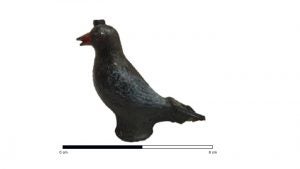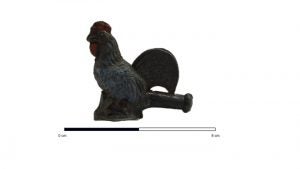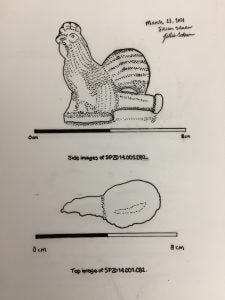Author: Jillian Schuler
Ownership, Curation and Conservation
Salvaging efforts on the wreck resulted in the North Carolina Maritime Museums of Beaufort and Southport holding a sizable assemblage of artifacts from the wreck after the salvager, Wayne Strickland, gifted the items to the museum. Included among these artifacts are many toys and trinkets, believing that the wreck was carrying presents for the upcoming holiday season. The museums have assumed the responsibility of conserving the artifacts, and currently hold them in storage between the two museum locations. Among these salvaged remains were two bird-shaped whistles.

Description of Whistles
The first whistle, SP2014.001.093, is the larger of the two whistles with a height of 2.5 inches and a width of 3.125 inches. The mouthpiece of the whistle is located at the tail of the bird, with an air escape hole located on the top of the bird’s head, although it appears that it may be broken. The whistle, likely made of pewter poured into an iron mold indicated by the visible seams around the edges of the bird, remains largely intact, although there is a hold in the back of the right side of the bird’s head, when facing the back of the bird, where the pewter has broken down. There is residual red paint on the eyes and beak, with blue paint on the wings. Likely lead painted, the fact that there remains this much paint after several decades in the ocean indicates that the whistle must have been vibrantly painted. The whistle also has a marking on the top of the mouth piece, “I A T으,” likely a production number.

The second whistle, SP2014.001.092, is smaller than the first whistle and has the unmistakable shape of a rooster. The whistle has a width of 3.5 inches. The mouthpiece is a long tube that extends from underneath the tail feathers, however the air escape hole is unidentifiable. It must come from somewhere below the bird, as it appears that there is a hole from underneath the bird, although it is currently covered with concretion. From the edges of the bottom of the whistle, it appears as though it was part of a larger whistle, as there are remnants along the edges that look like glue. Whether this was a part of original design, or if the material was applied to the whistle after it was salvaged is unclear. Similar to the first whistle, this one was likely also made of pewter poured into a mold and also retains some of its original paint; red paint remains on the wobble, around the eyes, and beak, and blue paint appears on the chest and very faintly on the tail feathers.

References
NC Maritime Museum Beaufort
2021 https://ncmaritimemuseumbeaufort.com/
New York Times
1878 Dangers Of The Sea: The Story Of The Wreck Of The Steamship City Of Houston–an Abandoned Schooner Rescued. New York Times (1857-1922).
<https://search.proquest.com/historical-newspapers/dangers-sea/docview/93713529/se-2?accountid=10639>. Accessed March 13, 2021.
